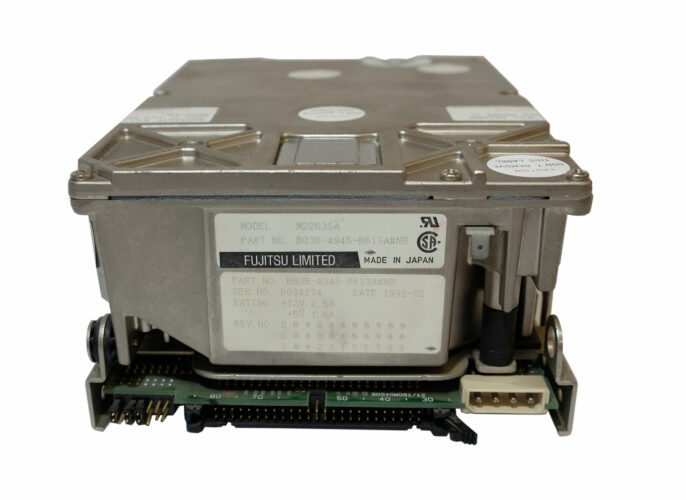Solid-state replacements for old technology drives can give decades-old systems a new lease of life.

Richard Warrilow is a technical author with Declaration Limited and a qualified electronics engineer.
Within many industry sectors, computers and computer-based systems that were designed and built decades ago are in regular use, are heavily relied upon, and must provide several more years of service.
In the telecoms sector, for example, operators are legally obliged to continue providing certain services; ones that run through old base stations and exchange system hardware. Meanwhile, in the aerospace and defense sectors there are, for example, radar systems, training simulators, and automatic test equipment (ATE) systems in use that were designed in the 1980s.
These systems were designed to use then state-of-the-art data storage devices such as early generation SCSI, IDE (PATA) hard disk and tape drives, and even ESDI, Shugart, and IDC floppy disk drives. With their moving parts, these drives are becoming increasingly unreliable. Understandably, they became obsolete years ago.
Moreover, it is the physical interface that is obsolete, so even finding a similar drive is challenging. And, even if one can be found, there are still likely to be problems. For example, SCSI was an extremely popular way of connecting computer peripherals in the 1980s (and through to the early 2000s). It was standardized in 1986 as the SCSI parallel interface (SPI) 8-bit wide, single-ended bus.
This standard evolved through several iterations, doubling the number of data lines to 16 and incorporating differential signaling before finally being superseded by the serial attached SCSI (SAS) interface. However, the word “standardized” should be taken with a pinch of salt because OEMs did not always implement the full standard. Instead, they often retained just the SCSI command protocol or the SCSI architectural model. Also, many SCSI drives were designed with a specific host in mind, and the latter would only physically interface with an exact make and model (number) of drive.
Furthermore, there are instances where a host system and drive were designed to behave in a mutually exclusive manner under particular circumstances. For example, the OEM of the host and the OEM of the drive might collaborate to agree things like mode page setting or a vendor unique mode page in the memory map. As another example, the OEMs may have agreed on certain handshaking protocols when messages between the host and drive take place.
Such pairings between hosts and drives was a common practice, meaning a secondhand drive required to keep a host computer operational might need to come from an identical host. This is an extremely unlikely find and, even if one can be found, what will be its life expectancy? Also, the host might be able to “recognize” that a new drive has been inserted, in which case it might look for certain data to be present (i.e., not just lots of zeros); again, something that might have been agreed between the OEMs.
It is also worth noting that many systems engineers (particularly in aerospace and defense) recognized that the drive was potentially a weakness in the reliability of the host system and had the foresight to buy spares and place them in storage. To their dismay, users are now finding these spares are crashing when powered up. Again, the use of moving parts is the problem. In the case of HDDs, many models had heads that rested on the surface when not spinning. Over time the heads may have stuck to the surface. This may result in preventing the disks from spinning or ripping the heads from their suspension mechanisms.
In essence, the failure of such a drive is a serious issue. Finding an exact-match secondhand drive is challenging, and an out-of-the-box unused spare that has been in storage for years is likely to crash.
Importantly, modifying the host is impractical in most cases because it would need to spend too much time offline. Moreover, modification might not be permitted. In the defense sector, for example, the host system’s functional behavior will most likely have been certified. A replacement drive that can be quickly swapped in is the only logical solution.
Emulation
In recent years a few companies have set up specializing in the design and manufacture of solid-state-based storage devices that can replicate the behavior of these yesteryear data storage drives, even if they were paired to a specific host.
One such company is UK-based Solid State Disks Limited (SSDL). SSDL has produced hundreds of solid-state drives over the years, so the good news—for anyone in need of replacing an electromechanical drive—is that the company has probably replicated it before. In this case, the designs (including software drivers) will already exist, and a drive can be quickly manufactured.
But what if a design does not already exist? And how were these existing replacements made in the first place, particularly if the OEMs had tweaked the SCSI standard or done other things to lock in their drive? SSDL Chief Technology Officer, Brian McSloy, explains: “Some details of the original drive and its interface might be available online. If not, we use techniques we’ve developed to interrogate a working drive, either one of the many we have in our engineering department, or a sample supplied by a customer.”
McSloy goes on to say that analysis equipment can always be taken to the host and placed between it and the drive so that signal timings and protocol can be captured.
“This is not an ideal situation though,” adds McSloy, “as we clearly need access to a working drive. Ideally, we need to be brought in before the original drive fails. And, even then, we need to take extreme care when handling the original drive as it will have become very fragile over the years.”
Preparation
Most legacy drives are based on logical blocks, where the exact encoding of the data onto the disk is handled internally by the storage device. For some classes of device, such as ESDI or floppy, the encoding has to be implemented within the new storage device’s firmware. McSloy says this is a complex operation that can only be achieved by reverse engineering the particular implementation, including a detailed low-level examination of the format written to the media, which sometimes varies across the surface.
Also, the solid-state drive needs to be formatted and, as mentioned above, if the host is expecting to see certain data present to indicate it is a new drive, it will need to be present too. “However,” adds McSloy, “some hosts will require the old data to be present on the new drive, in which case it needs to be copied. Again, that means having access to a working drive and taking great care when handling it to copy the data.”
In essence, a solid-state replacement can be created for virtually any SCSI-based drive that was in use in the 1980s to early 2000s, irrespective of how the OEMs of the host and drive (companies that may no longer exist) might have collaborated to uniquely pair their products.
As previously mentioned, modifying the host is impractical, or impermissible in some cases. However, since a solid-state drive can be equipped with the same physical connector, interface protocols, memory maps, formatting (including pre-loaded data, if applicable) as the original drive, the host does not need to be modified. “The host will not be aware that a solid-state drive has been fitted,” adds McSloy. “And in many cases, we need to slow down the speed of our drive. For instance, to retrieve data, a tape drive might need to rewind the tape. That takes time. We can provide the data almost instantly, but the host might not be ready for it so soon and flag it is as unusual behavior.”
Solid-state benefits
With solid-state, reliability is greatly improved (as there are no moving parts) and the drive draws a lot less power than the original electromechanical drive.
It is quieter too. As for the storage media itself, SSDL has historically used industrial grade Compact Flash (CF) cards, which can be removed and treated like floppy disks, for example.And if the solid-state drive is replacing an HDD, a CF card is still the storage media, but hidden behind a plate
so it cannot be removed.
For its latest products, SSDL has switched to M.2 SSD for drives without removable media and CFast for removable media (though, as before, it can be made inaccessible). “Where removable media is concerned,” adds McSloy, “CF is starting to fall out of favor and tops out at 64G capacity for the highest endurance class. CFast goes up to 1TB.”
McSloy concludes by saying that obsolescence is a moving target, which means SSDL must move with the times. “For instance, many drives of the 1980s and 1990s were 8-bit and had read-write speeds of no more than 10MB/s. Now, drives from the 2000s are showing signs of wear and we are receiving more and more requests for 16-bit wide SCSI with read-write speeds of up to 80MB/s.”
In summary, the behavior of virtually any drive can be replicated in a solution that is more reliable, draws less power, and is more secure, and no modifications need to be made to the host. Also, the solid-state drive can be given features, such as networking, that the original drive never had, thereby opening a whole new world of opportunities.

